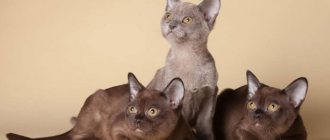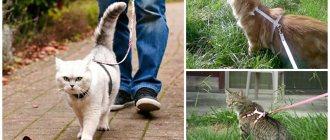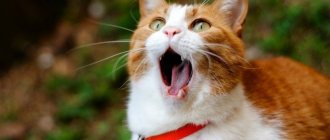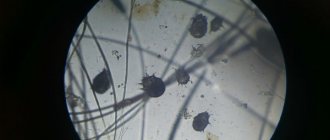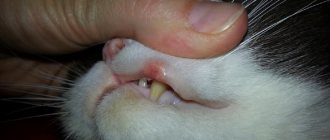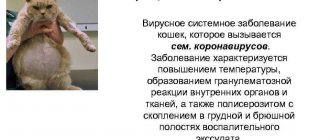The third eyelid (nictitating membrane) is a thin light film in the corner of the cat's eye, which protects the mucous membrane of the eyes from damage and dust. It secretes a certain amount of tear fluid, which, when blinking, wets the surface of the eyeball and thus collects foreign particles and traps bacteria. Normally, this membrane can only be seen in a cat when blinking or tilting the head, so if the third eyelid appears in other situations, you should take your pet to the veterinarian, even if there are no other symptoms. This phenomenon not only causes discomfort to the pet and blocks vision, but can also be a manifestation of health problems and even threaten blindness.
Vestigial organ or not
The inner eyelid is also called blinking and is perceived by some as an atavism (similar to the appendix in humans). Almost all animals have this organ.
Having developed at the beginning of evolution, the eyelid still continues to perform its functions, so it cannot be called rudimentary. But a century ago, experts considered the organ useless and recommended its removal: supposedly, the film prevents the animal from seeing better.
Modern biologists do not agree with this statement.
They are sure that the cat’s inner eyelid is in demand and perfectly fulfills its purpose, i.e. is an active organ, not a rudiment.
Structure of education
Once upon a time, humans also had a blinking eyelid. Now all that remains of him is a memory in the form of small bumps in the corners of his eyes. In animals, the structure of the organ has not changed and is a complex “construction”.
The eyelid is impressive in size, but most of it is hidden in the eye socket. In a awake cat, only a small section of the membrane in the shape of a crescent can be seen.
Essentially this is a fold of the conjunctiva located in the medial corner of the eyeball.
When it opens, the membrane covers the cornea on one side, and the inner surface of the upper and lower eyelids on the other.
The nictitating membrane is held in place by a special T-shaped cartilage (or rather, its horizontal bar). The vertical “leg” is girded by a system of glands that produce tears.
On the bulbar surface (in the area of the sclera) there are follicles that act as lymphoid nodes. All components are connected into one operating mechanism called the third eyelid.
How to determine
Firstly, if the cat still seems small to you, then in order to calculate its age, you can simply wait until it reaches puberty, which usually occurs at 8-10 months. But it can happen either earlier (at 6-8) or later, so this method is still not accurate. In addition, you need to take into account the age to which cats grow; puberty should not be confused with physical maturation, which can only occur at one and a half years.
The second method provides more accurate information, but it is somewhat more complicated - you can determine the age of a cat by its teeth. In kittens, attention should be paid to the eruption and loss of baby teeth. They appear already at the age of 1 month, and fall out at about six months. Determining the age of a cat by its teeth is the most convenient and accurate method, which has been thoroughly studied by felinologists and has helped more than one owner. Of course, before making calculations, it is best to clearly see what a cat’s teeth look like at any period of its life, but, in principle, you can do without this, using only theoretical materials.
You can find out the age of a cat in this way not only in kittens, but in animals of almost any age. You need to carefully examine the cat's teeth and compare them with the others, determine how much the incisors are ground down. If the edge is uneven only on the lower jaw, the cat is approximately 2.5 years old. If the top one is also 3.5, but if the fangs are also ground down, she is already more than 5 years old. Teeth begin to fall out after 10 years, the maximum age of a cat with preserved incisors is 15 years, after which even the fangs begin to fall out.
Functions of the eye membrane
The secretion secreted by the cartilage glands washes the cornea, providing lubrication to the moving eyelid. The membrane is large enough to completely cover the cornea.
It was not by chance that nature endowed ancient animals with an organ.
Predators (which include cats) were forced to hunt, making their way through forest thickets, fight with “competitors”, defending their prey, and therefore the eyes needed reliable protection
Domestic cats remain predators by nature, and the internal membrane continues to fulfill its “duties.”
| Name | Meaning |
| Protective | In combination with the outer eyelids, protects the eyes from damage |
| Cleansing | During the blinking process, it removes small particles that fall on the cornea |
| Moisturizing | Transports tear fluid across the cornea, preventing it from drying out |
| Immune | Lymphoid nodules produce immunoglubogulin secretion, which provides protection against infections |
The membrane comes into play when the cat's eyes close.
The fold, straightening, moves from the inner corner to the outer. On its way, it sweeps away all small debris and evenly distributes the tear over the entire surface of the eye.
Following doctor's orders at home
When a diagnosis is made and therapy is prescribed by a professional doctor, strict compliance with all the veterinarian’s instructions is very important. It is of no small importance to provide the sick animal with good conditions, rest and adequate nutrition. It is advisable to exclude physical activity.
Several times a day, it is necessary to rinse the cat's eyes with the help of special preparations that relieve inflammation, stimulate self-cleaning and prevent the formation of tear stains.
After rinsing, special eye drops are usually used. Which ones exactly - the doctor decides. Drops are the most acceptable and convenient form of the drug, since gels and ointments are much more difficult to apply. Such medications should be placed under the animal’s lower eyelid with the index finger. To distribute the product evenly, massage the organ of vision.
Gently washing a cat's eyes
Third eyelid prolapse: causes
When the animal falls asleep, the muscles relax and the membrane partially covers the eye.
But if the cat does not try to fall asleep, and the film captures part of the cornea, they speak of organ prolapse.
Why is this happening
| Factor | Peculiarities |
| Injury | Usually occurs in a fight, or when a cat crawls through the jungle, runs into sharp objects, and falls unsuccessfully. Prolapse occurs when part of the membrane is torn off or cartilage is damaged. |
| Foreign body | Small litter and dust particles are not a hindrance to formation. But if a larger object gets into the eye, it can damage both the cornea and the membrane. |
| Eye diseases | Conjunctivitis, uveitis, keratitis, erosion and other ophthalmic problems irritate the eyes, making the cat want to scratch them. Education is also connected here, the animal involuntarily blinks (to remove the stimulus) |
| Parasites | Worms travel throughout the body and can also lodge in the tissues of the eyelids, injuring them. In animals weakened by diseases, fleas can be seen in the corners of the eyes, which often cause damage to the membrane and the development of infections. |
| Adenoma | The factor is rare in cats (usually in exotic breeds). But if the growth is localized on the eyelid, it will prevent the membrane from folding normally |
| Internal illnesses | Colds, digestive problems, and malfunction of vital organs weaken the pet. Internal pathologies can lead to inflammation of the mucous membrane of the eyes, conjunctiva, and cause weakening of the muscles that hold the fold together. |
| Cartilage crease | Eversion is observed with pathological abnormalities in eye development. The cartilage becomes distorted and causes the membrane to protrude outward |
| Prolapse | Refers to the membrane's own diseases and is more often observed in bracephalous breeds (with a flattened muzzle). The growth of the skull does not keep pace with the enlargement of the eyes, resulting in a rupture of the ligament holding the membrane |
Not only the smooth muscles of the eyes are responsible for moving the inner eyelid. Movement is regulated by the sympathetic nervous system.
Some medications used in the treatment of internal and eye diseases can inhibit impulses sent to the third eyelid.
Skull injuries and inflammation of the meninges lead to system failure.
One of the reasons is the stress suffered by the cat during surgery for castration, sterilization, etc.
Anesthesia temporarily inhibits all reactions. When the animal moves away from him, the half of the eye remains covered with a bluish eyelid.
Life periods of cats
When comparing ages, zoologists and breeders proceed precisely from the physical, psychological and emotional state in which the compared animals and people are at different periods of their lives.
For cats, as for humans, the following age stages are characteristic:
- Infancy, which occupies the first month of life in quadrupeds. Kittens acquire teeth 3-4 weeks after birth, after which they can be fed solid food. At the age of 1-2 months, fluffy balls actively explore the surrounding area, move independently, and react to external stimuli. Such properties begin to appear in 6-8 month old children. At 3-4 months, a kitten is similar in development to an 8-year-old child. At 8-10 months this is already a 14-16 year old teenager.
- Childhood, adolescence. A one-year-old kitten, in human understanding, goes through the stages of childhood and adolescence. Kittens develop at a rapid pace, so in 1 year they manage to cover as much ground as a human in 18 years. During this period, puberty occurs and character and lifestyle are finally formed. Since cats are quite self-confident and independent, changing the habits acquired by the animal at a later age will be problematic. This age of cats is characterized by increased activity - tailed cats are playful, are interested in the world around them, and begin to flirt with the opposite sex. Hunting instincts also appear - rat catchers and bird catchers can boast of their first successes. The size of the animals approaches the size of adults.
- The second year of a cat's life begins the period of youth. At two years old, animals are full of strength and energy, but at the same time they are already fully formed physically and mentally, able to exist independently. Naturally, the tailed animals are not going to leave the house and go to a permanent place of residence in the basement, but individuals prone to partying break out by all means. As a rule, after relaxing in nature, animals return home on their own after 3-4 days, in order to go back to new friends after some time. The lifestyle of animals is very diverse. Many cats like to leave in the morning and return home to spend the night; some are able to disappear for a long time and then, hungry and full of food, return to their home for a long time. There are particularly impudent individuals who can just as easily spend the night and feed themselves with compassionate neighbors, but in the end they will still prefer their own home. Isn't it true that all this is very reminiscent of the behavior of young people?
- Maturity occurs at the age of 6-10 years, which corresponds to 40-60 years in humans. The number and duration of parties decrease, animals like to sleep in comfortable conditions, and sexual activity decreases. Outwardly, four-legged cats become more sedate and calm; candy wrappers and shreds no longer attract their attention, although many cats remain playful until their last days. At this age, the development of age-related diseases is possible; unsterilized animals and nulliparous cats are at risk.
- Old age comes to cats after 10 years. Animals become less active, sleep or rest more. At this age, you need to treat your pets more carefully - do not expose them to stress, provide stable and high-quality nutrition, do not let children annoy them with games and excessive affection. Cats no longer have their former strength and dexterity; if necessary, they need to be helped to climb to their favorite place on the cabinet, do not change their diet, and do not move bowls of food and water. The appearance of other pets at this age, especially puppies, will cause stress in the animal. In old age, four-legged animals may require the help and supervision of a veterinarian, feeding with vitamins and special supplements. All this is typical for people of the same age. With proper care, animals will remain vigorous and continue to delight you. In any case, even older animals remain the same graceful and cute creatures with exorbitant pride and a sense of superiority over everyone around them.
Characteristic symptoms
If the eyelid comes out and covers part of the cornea even in a waking cat, you need to carefully observe the pet to determine other signs of loss of the protective film.
Associated symptoms are:
formations in the corners of the eyes have taken on a significant volume;- profuse lacrimation;
- the appearance of mucous or purulent discharge.
Eyelid loss in both eyes may be accompanied by blepharospasm . The pathology is manifested by involuntary contractions of the circular muscles, causing spasmodic closure of the upper and lower eyelids.
Video
In the structure of the cat's eye analyzer there is a translucent membrane called the third eyelid. In a healthy pet, this formation is noticeable only when blinking and half asleep. But in some cases, the fold at the inner corner of the eye swells and extends beyond the lower and upper eyelids. This situation in most cases is a consequence of serious causes and requires timely treatment.
A cat's third eyelid performs several important functions. It protects the cornea of the eye from irritating particles from the outside, distributes the secretion of the lacrimal gland over the surface of the eyeball, and protects the mucous membrane from drying out. If the membrane falls out and becomes noticeable when the cat's gaze is open, then this is a signal for alarm. The reasons for this phenomenon may be different.
Diagnosis of pathology
Only a specialist in a clinical setting can make an accurate diagnosis and identify the cause. Therefore, if a bluish spot appears on the eye and animal, the pet must be urgently taken to the veterinarian.
A comprehensive examination includes:
taking anamnesis (according to the owner);- visual inspection;
- blood tests (general and detailed);
- biomaterial from the conjunctiva;
- hardware studies - CT (MRI), ultrasound.
Specialized ophthalmological diagnostics are also required. During the examination, the pet's intraocular pressure is measured and examined using optics. Staining the pupil with fluorescein allows you to study the condition of the cornea.
Prevention
To prevent the development of eye diseases and, in particular, third eyelid adenoma, follow fairly simple rules:
- carefully monitor the hygiene of the animal;
- ventilate the room daily;
- Take care of your cat's eyes every day;
- provide a nutritious, varied diet and supplement it with vitamin supplements;
- Wash your pet’s clothes and bedding as often as possible;
- If you notice signs of the disease, do not hesitate to go to the doctor.
Treatment of abnormalities
Self-therapy for this pathology is excluded. You cannot reset a prolapsed membrane at home.
The pet will have to be treated in a hospital setting. The veterinarian decides which method to choose (passive or operative).
Drug treatment
The course of therapy is selected based on the cause that provoked the pathology.
Usually prescribed:
- drugs for healing an injured eye;
- antibacterial drops and ointments;
- antihistamines (for allergic conjunctivitis);
- hygiene lotions.
At the same time, they treat internal diseases and fight parasites.
Weakened animals are prescribed vitamin preparations. In some cases, hormonal therapy is resorted to.
Surgical intervention
Surgery is required in rare cases when a cat begins to have vision problems due to a protruding eyelid. This is usually observed during the formation of an adenoma.
Eversion is also surgically eliminated (cartilage damage cannot be treated with conventional medications).
Do folk remedies help?
Homemade recipes will not help with eyelid loss. But you can use herbal decoctions to wash the eyes if the cause of the formation is associated with inflammation of the conjunctiva.
What to do at home
The owner must strictly follow the veterinarian’s instructions and provide the pet with good living conditions, rest and adequate nutrition. It is recommended to reduce physical activity.
Under no circumstances should you self-medicate or use medications purchased without consulting a specialist. But phytomineral fertilizer containing ivy bud, plantain, cornflower and calendula can be given without fear.
Remember that if you try to insert a membrane yourself, you can cause irreparable harm to your vision.
During treatment, the cat must rinse its eyes. But for this you should not use the good old folk methods, such as strong tea, but special drugs that relieve inflammation.
A good result is obtained by the Beaphar Oftal eye wash, sold in a veterinary pharmacy. It does an excellent job of cleaning the eyes and fur around them from debris, stimulates self-cleaning and prevents the appearance of tear stains.
After washing the organ of vision, eye drops are used. Among those recommended by veterinarians are Actipol, Levomycetin, Floxal. These drugs are most effective for conjunctivitis and infections. The use of two drugs simultaneously enhances the therapeutic effect. As a rule, experts advise combining Floxal with Korneregel. The course is at least 14 days.
Drops are the most optimal form of the drug. Gel or ointment is much more difficult to apply. The drug is placed under the lower eyelid with the index finger (in no case directly from the tube!).
To ensure that it is evenly distributed, the eye must be massaged. Immediately before the procedure, nails should be trimmed, otherwise the cat may be injured.
The pet will resist manipulation, so it needs to be secured with a blanket or thick towel.
Preventive measures
Cats with bulging eyes are more susceptible to hair loss. But representatives of other breeds should also be given no less attention to avoid problems.
Prevention includes:
periodic visits to the veterinarian for the purpose of timely detection of diseases;- regular deworming of your pet;
- compliance with vaccination schedules;
- treatment for ticks and fleas.
A balanced diet supports your pet's immune system. Limiting contact with stray animals helps avoid injury and infection.
